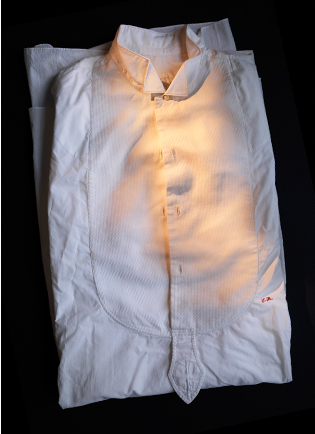OSCAR WILDE’S INFLUENCE IN both his prose and personal style has reached a mythical and iconic status, yet of the writer’s personal wardrobe only a white dress shirt has survived. So it’s almost perfect for the man of such grand reputation and words that only a simple shirt remains, but its survival is owed to a sum of coincidence. In the book Artist/Rebel/Dandy: Men of Fashion, author and grandchild of the writer, Merlin Holland, wrote an article on the provenance of the garment that offers an interesting insight to Wilde and his approach to dressing. Here on the Vestoj Online we recently published an article by Hampus Hagman, ‘The Monochromatic Power of the White Shirt’ which looked critically at the garment type. In light of this, Holland’s piece gives insight into the personal effects of Wilde – and the shirt in question – but moreover the power of this fashion archetype as a canvas for human and fictional imprint.
In his quick-witted prose and commentary, Wilde quotes still ring true today, capturing the duplicity at the essence of fashion by summing up a sentiment in such a way that if you blink you might miss the power of his words: ‘And after all, what is a fashion? From the artistic point of view, it is usually a form of ugliness so intolerable that we have to alter it every six months.’ This holds as much relevance now as it did when it was written, in distinguishing the line between what is ‘fashion,’ and what is ‘fashionable’. A centrepiece to his writings on dress is the essay ‘The Philosophy Of Dress’, first published in 1885 in The New York Tribune, but over the years Wilde’s own clothes and dress have garnered much notoriety and mythology through his association with dandyism and bohemia.

***
Excerpt by Merlin Holland from Artist/Rebel/Dandy: Men of Fashion, 2013:
Oscar Wilde’s last shirt owes its survival to being in the wash when he died in Paris on November 30, 1900. Had it not been, his close friend and literary executor, Robert Ross, would almost certainly have disposed of it, as he did Oscar’s other personal possessions of no monetary or sentimental value. It survived thanks to the Dupoirier family, who owned the Hôtel d’Alsace, where Wilde was a long-term resident. A few items that had belonged to Oscar surfaced later, and Jean Dupoirier kept them as mementos. There were the shirt, two trunks of books and magazines, a pile of rough jottings that Dupoirier burned, an umbrella that he subsequently lost, and finally, a set of false teeth.
When the French commemorated the fiftieth anniversary of Wilde’s death, the organizing committee invited my father, Vyvyan, to be present. He, who had a horror of such events, saying they made him feel like a performing monkey, refused and sent my mother in his place. At the Hôtel d’Alsace, she met Dupoirier’s daughter, who offered her both the shirt and the dentures; my mother accepted the shirt but turned down the teeth as being too gruesome. Had it been my father, I know he would have taken neither, so the shirt has survived quite against the odds. Of the dentures there is (perhaps fortunately) no trace.
The shirt, with attached wing collar, waffle piqué front, and single cuffs, appears to have been an evening dress shirt. It is embroidered on the left breast with the initials “S.M.,” which stood for Sebastian Melmoth, Wilde’s pseudonym in exile, and with the date it was made, 1899, under the buttonholed tab designed to fasten the shirt to the trousers and prevent it “riding up.” It would have been worn with a collar stud and cuff links, although such luxury, implying a suit to go with it, seems incongruous with Oscar’s finances at the time. On the other hand, despite his enforced bohemian lifestyle, he still craved the company of those who stimulated him, who cared nothing for his disgrace and occasionally invited him to dinner, for which a tenue de soirée would have been the norm.
Oscar loved clothes, certainly, but they weren’t his raison d’être, and he was hardly a “dandy” in the accepted sense of the word. He dressed like a long-haired aesthete when he came to lecture in America in 1882; cut his hair and dressed like a smart man about town when he married; and when he came out of prison, dressed as well as he could afford to, sometimes thanks to the generosity of his friends. When in 1898 Ross sent him a new suit from the West End tailor James Doré, Oscar wrote with humor as well as gratitude: “The clothes are quite charming−suitable to my advanced age. The trousers are too tight round the waist. That is the result of my rarely having good dinners: nothing fattens so much as a dinner at 1 fr. 50.” All the more reason to keep a set of dress clothes handy for those occasions when you were invited to eat well.
Artist/Rebel/Dandy: Men of Fashion was published by Yale University Press in 2013.